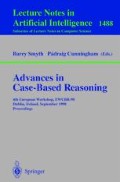Abstract
In this paper the C-CLASSIC Description Logic is used to design the retrieval and selection tasks of a Case-Based Reasoning system with homogeneous, explicit and formal criteria. The case base is organized by means of a taxonomy of index concepts. Case retrieval is performed using the automatic concept classification of the description logic. Case selection is performed using two criteria: similarity and dissimilarity. Similarity between two cases is characterized by the most specific concept which subsumes the two cases (Least Common Subsumer or LCS), and dissimilarity by a concept representing properties which belong to one case but not to the other. A partial order induced by the subsumption relationship on these concepts is used to select the most similar cases.
Preview
Unable to display preview. Download preview PDF.
References
Howard W. Beck. A conceptual clustering algorithm for semantic data models. In International Workshop on Terminological Logics, Document D-91-13, pages 17–22, Schlo\Dagstuhl, Germany, 1991.
A. Borgida and P. F. Patel-Schneider. Complete algorithm for subsumption in the CLASSIC description logic. Artificial Intelligence Research, 1:278–308, 1994.
R.J. Brachman. A structural paradigm for representing knowledge. Technical Report 3605, BBN Report, 1978.
W. W. Cohen, A. Borgida, and H. Hirsh. Computing least common subsumers in description logics. In 10th National Conference of the American Association for Artificial Intelligence, pages 754–760, San Jose, California, 1992.
R. Dionne, E. Mays, and F.J. Oles. The equivalence of model-theoretic and structural subsumption in description logics. In 13th International Joint Conference on Artificial Intelligence, pages 710–716, Chambéry, France, 1993.
G. Kamp. Using description logics for knowledge intensive case-based reasoning. In Springer-Verlag, editor, Advances in Case-Based Reasoning, Third European Workshop on Case-Based Reasoning, EWCBR'96, volume 1168 of Lecture Notes in Artificial Intelligence, pages 204–218. I. Smith and B. Faltings, 1996.
J. Koehler. An application of terminological logics to case-based reasoning. In Principles of Knowledge Representation and Reasoning, Proc. of 5th International Conference, pages 351–362, Bonn, Germany, 1994.
J. Koehler. Planning from second principles. Artificial Intelligence, (87):145–186, 1996.
A. Napoli, J. Lieber, and R. Curien. Classification-based problem-solving in casebased reasoning. In Springer-Verlag, editor, Advances in Case-Based Reasoning, Third European Workshop on Case-Based Reasoning, EWCBR'96, volume 1168 of Lecture Notes in Artificial Intelligence, pages 295–307. I. Smith and B. Faltings, 1996.
E. Plaza. Cases as terms: A feature term approach to the structured representation of cases. In Springer-Verlag, editor, Case-Based Reasoning, Research and Development, First International Conference on Case-Based Reasoning, ICCBR'95, volume 1010 of Lecture Notes in Artificial Intelligence, pages 265–275. M. Veloso and A. Aamodt, 1995.
S. Salotti and V. Ventos. Etude et formalisation d'un système de raisonnement á partir de cas dans une logique de descriptions. In Actes Journées Ingénierie des Connaissances Acquisition Apprentissage, JICAA97, pages 629–642, Roscoff, France, 1997.
S. Salotti and V. Ventos. Une approche formelle du raisonnement á partir de cas dans une logique de descriptions. Revue d'Intelligence Artificielle (to appear), 1998. 13. V. Ventos. A deductive study of c-classic· In Proceedings of the International Workshop in Description Logics 96, pages 192–196, Boston, USA, 1996.
V. Ventos. C-CLASSICδε: une logique de descriptions pour la définition et l'apprentissage de concepts avec défauts et exceptions. PhD thesis, Université Paris-Nord, France, 1997.
Author information
Authors and Affiliations
Editor information
Rights and permissions
Copyright information
© 1998 Springer-Verlag Berlin Heidelberg
About this paper
Cite this paper
Salotti, S., Ventos, V. (1998). Study and formalization of a case-based reasoning system using a description logic. In: Smyth, B., Cunningham, P. (eds) Advances in Case-Based Reasoning. EWCBR 1998. Lecture Notes in Computer Science, vol 1488. Springer, Berlin, Heidelberg. https://doi.org/10.1007/BFb0056341
Download citation
DOI: https://doi.org/10.1007/BFb0056341
Published:
Publisher Name: Springer, Berlin, Heidelberg
Print ISBN: 978-3-540-64990-8
Online ISBN: 978-3-540-49797-4
eBook Packages: Springer Book Archive

